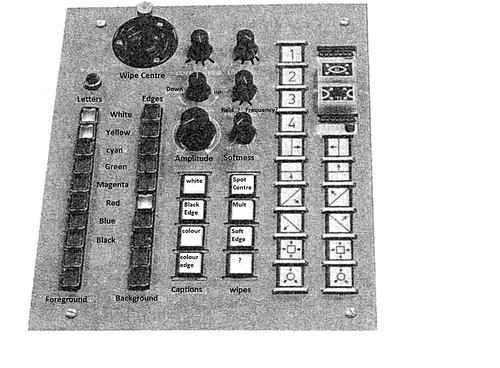
The inlay desk was basically a camera aiming down at a backlit desk. But it does appear to have more controls than just being a camera. Unless of course, those controls to the left side of the operator are just a form of CCU. Apparently, as the studios were colorized they were upgraded accordingly to have multiple layers of video color separation. Can't image how that would look or work, but sounds pretty awesome. In this particular picture it's neat to note that the camera looks almost exactly like the camera in the NODDY array. This is probably not too much of a surprise because the NODDY array was basically a generator of keyed graphics (at least when color came around).
Not too much out there on this piece of equipment. Most of the info I have comes from TV Studio Histories again. I can't find too many mentions of it in engineering documents, but it also took me a while to learn that EP5/512 meant "that video mixer with the faders."
If one were to piece some things together from the aforementioned website, there is discussion about the formulation of a video effects studio. Until it was built, video effects were done in the galleries of TV studios that were undergoing a set change and therefore idle. This was most likely one of the pieces of equipment they used to generate the various effects, as every studio gallery had one. There is however, no mention of the device being installed in the new video effects studio, but by that time, the 80s, I would assume it was probably thought obsolete.
This device does kind of remind me of another device developed in America, although with greater and different capabilities, called scanimate. Scanimate had an input device that was similar to this setup, but could do more, in the sense that it could alter the scan rate of its camera. This ability had the effect of making things "roll" as the image produced by the camera was re-photographed with a standard camera. Essentially it took advantage of the effect that occurs when you try to film a CRT screen. There was way more to it, but we were trying to stick to the BBC weren't we?
On a personal project note, I have been playing around with transistors (still) and am working on several guitar pedal-like devices as well as germanium input amplifiers for microphones. In addition, also bringing an ADAT digital tape recorder back to life. Perhaps another week.
To leave you today, I found a cool video montage about Television Centre that has become one of my favorites. Enjoy



